Simple Sourdough Focaccia Bread [bubbly + delicious]
This post may contain affiliate links.
You need a good sourdough focaccia bread recipe in your collection. This sourdough focaccia recipe is super simple - it really just requires patience - but that's not new for sourdough, right?
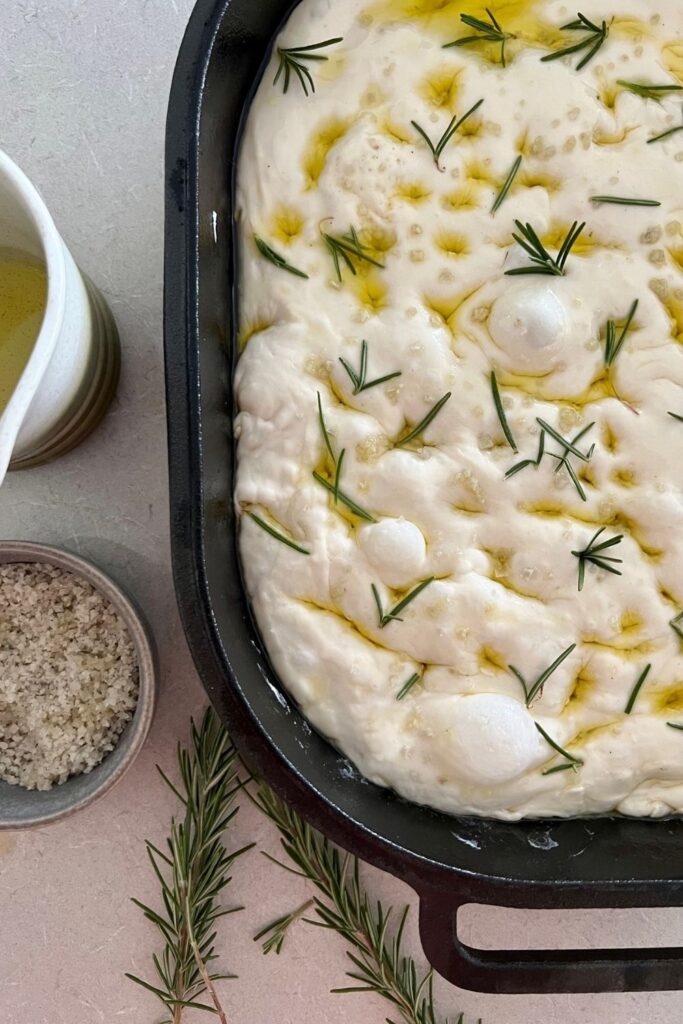
You can top sourdough focaccia bread with anything you like! I love the classic flavors of sea salt and fresh rosemary, but I've put some other suggestions further down for you to try. You're really only limited by your imagination! And if you love trying different toppings, check out these sourdough focaccia bread muffins.
I know you don't want to know my life story ... but focaccia bread is something that I have been making from scratch since I lived in Italy as a teenager. Back then I made it with yeast, but now I love that I can make it even more special by using my sourdough starter. It really does add a depth of flavor that you just can't get from commercial yeast.
Why You'll Love This Recipe!
Simple Ingredients - Flour, water, salt, olive oil and whatever herbs you have on hand are all you need to create this delicious bread.
No Fancy Equipment - you don't need a stand mixer for this recipe, a bowl and spatula is just perfect. It's a wonderful beginners recipe!
Endless Flavors - there's no limit to the flavor combinations you can create with this simple sourdough focaccia recipe! From sweet to savory, you're only limited by your imagination.
What is Sourdough Focaccia Bread?
Focaccia is an Italian bread, generally baked with good quality olive oil, fresh rosemary and salt. It is said to be similar to sourdough fougasse. Its magic lies in its simplicity.
Traditionally it's made with yeast (and more yeast than regular bread). Baking it with lashings of olive oil mean that it has a crusty, golden bottom and top with a light, yet chewy crumb inside. It's quite springy and spongey.
Similar to pizza dough in many ways, focaccia is sometimes referred to as "pizza bianca" or white pizza because it doesn't have the toppings that a pizza does.
Sourdough bread made with ripe sourdough starter has a deep sourdough flavor. It's fermented for a long time to develop the signature bubbles. Using a strong sourdough starter will give you the best chance at developing gorgeous bubbles as the dough ferments.
The time your focaccia bread takes will depend on the strength of your sourdough starter.
Ingredients
- Sourdough starter - This simple sourdough bread recipe requires a strong sourdough starter that's active and bubbly.
- Water
- Bread Flour
- Salt - I use regular fine salt for making the dough and then add flaky sea salt to the top of the dough before baking in the oven.
- Extra Virgin Olive Oil
- Rosemary Leaves - you can use fresh or dried rosemary, or really any dried or fresh herbs you like. Italian seasoning is really lovely with this if you don't have fresh rosemary on hand. If your rosemary bush is laden with leaves, you might also like to try this sourdough olive bread or this sourdough parmesan and rosemary wreath.
How To Make Sourdough Focaccia Bread
This beautifully simple recipe has very few hands on steps. It starts out as a wet, soupy mess, but through the power of fermentation, turns into a light, bubbly bread that will easily become your favorite!
You'll need a healthy, active sourdough starter that has been fed and is at its peak. This will give you the best chance of getting those beautiful bubbles (seriously whatever you do, don't pop these).
- Here's how to make bubbly sourdough focaccia bread:
- Weigh out your active starter and water into a large mixing bowl. Mix the water and starter together briefly.
- Then add flour and salt and mix whole lot together until it forms a sticky dough. You don't want any dry flour left at all. You can use a jar spatula for this, it makes it much easier! Cover your bowl with cling film and let it sit for around 1 hour.
- After the dough has been through autolyse you need to bring it together into a ball. Work your way around the bowl, grabbing the dough from the outside, stretching it up and over itself, into the centre. You should feel the dough strengthen as you do this. It doesn't have to be perfectly smooth or tight, just work around the bowl stretching and folding (around 10 - 15 times is perfect).
- Now you want to leave your dough to bulk ferment at room temperature. Cover it with plastic wrap and leave it alone to double.
- Once the dough has doubled you need to shape the dough. Shaping sourdough focaccia is super simple (and absolutely forgiving).
- Oil the bottom of the pan you're going to use (or line it with some parchment paper). Use a dough scraper to gently ease the dough into a lined baking tray or cast iron skillet. Rub your hands with a little olive oil and gently pull the dough out to fill the tray. Again it doesn't have to be perfect as it will naturally fill the tray as it proofs.
- Let your dough rise again (this is the proof or second rise). Leave it until it's spread out and filled the tray. It will be puffy and pillowy ... you might even have some gorgeous bubbles popping up.
- Once the dough has filled the tray and is looking puffy and full of volume, you need to dimple the dough and add the toppings. Pour olive oil over the top of the dough and then push your finger tips into the dough to create dimples. You might see some bubbles pop up as you do this.
- Now sprinkle with sea salt and rosemary. Preheat the oven to 200C (390F).
- Bake for 30 minutes at 200C (390F) or until golden brown.
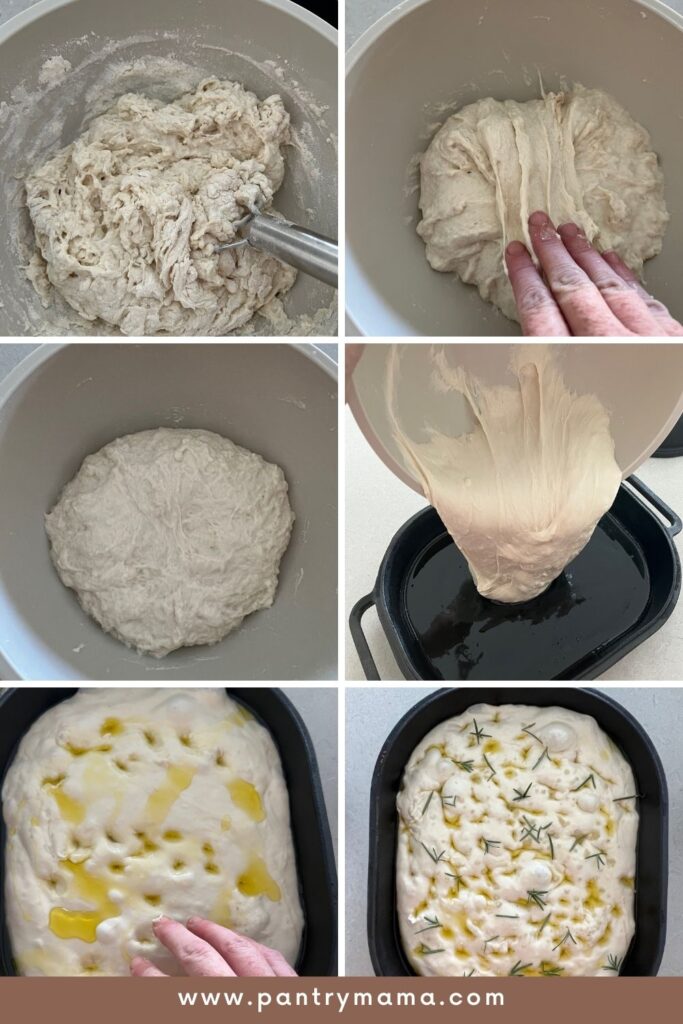
Baker's Schedule
Many people have asked for ball park timing for this recipe, so I've added a sample baker's timeline here. These are just guidelines, as the actual timing will depend on the strength of your sourdough starter and the temperature of your kitchen.
| TIME | PROCESS |
|---|---|
| 9.00 PM | Night Before: Feed your sourdough starter 1:3:3 so it peaks in the morning (learn about sourdough starter ratios). |
| 6.00 AM | Next Day: Mix together sticky dough and let it sit for around an hour. |
| 7:00 AM | Bring dough together into a sticky ball (one set of stretch and folds). Cover the dough and leave at room temperature to bulk ferment. |
| 12.00 PM | Once the dough has doubled, use a dough scraper to tip it into the baking pan of your choice, ensuring you use olive oil and/or parchment paper. Cover and leave for second rise. |
| 5.00 PM | Dimple the dough and add the toppings of your choice. Allow the dough to sit while the oven preheats. |
| 5.45 PM | Bake sourdough focaccia bread for around 30 minutes or until golden brown. |
| 6.15 PM | Remove from the oven and allow to cool for around 10 minutes in the pan. |
| 6.25 PM | Transfer focaccia to a wire rack to continue cooling or eat warm for dinnner! |
If you want to cold ferment the sourdough focaccia bread in the fridge overnight, the best time to do this is once you've shaped the dough in your chosen baking pan. Allow it to rise a little and then place into the fridge. Take the dough out a few hours before you want to bake it to allow it to come to room temperature. You want the dough to be puffy and full of bubbles before it goes in the oven.
What Baking Pan To Use?
You can really bake sourdough focaccia bread in any pan that has a lip - even a baking tray is fine. I have baked this bread many, many times and my favorite way to do it is in a cast iron pan with lashings of olive oil. Olive oil is the secret to ensuring your dough does not stick to the pan!
I first started baking this bread in a baking pan lined with parchment paper. It comes out perfectly fine - I just prefer it in cast iron. I think that the bottom crisps up a bit more.
Here are a few ideas of what to bake your focaccia bread in:
- Cast iron skillet or bread pan (the skillet I'm using is 39cm x 26cm (15 x 10 inches).
- Divide into two portions and bake in round cake tins lined with parchment paper (I do this with 20cm (8 inch) cake tins.
- Baking tray (either using olive oil or baking paper) - any medium sized tray is fine, the dough can stretch out to fit.
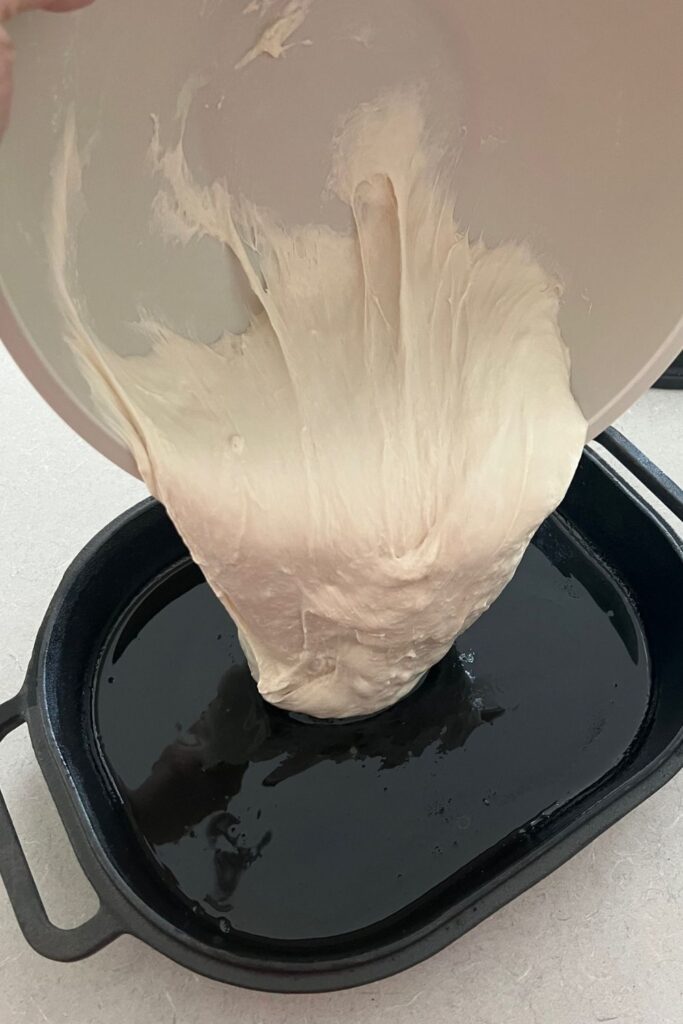
Troubleshooting Sourdough Focaccia Bread
While this recipe is seriously simple, there are still a few issues that can arise. Sometimes it's the most simple of recipes that can give us the most grief!
I thought I'd put together a few troubleshooting tips that you can use as a reference in case you run into issues while making this bread.
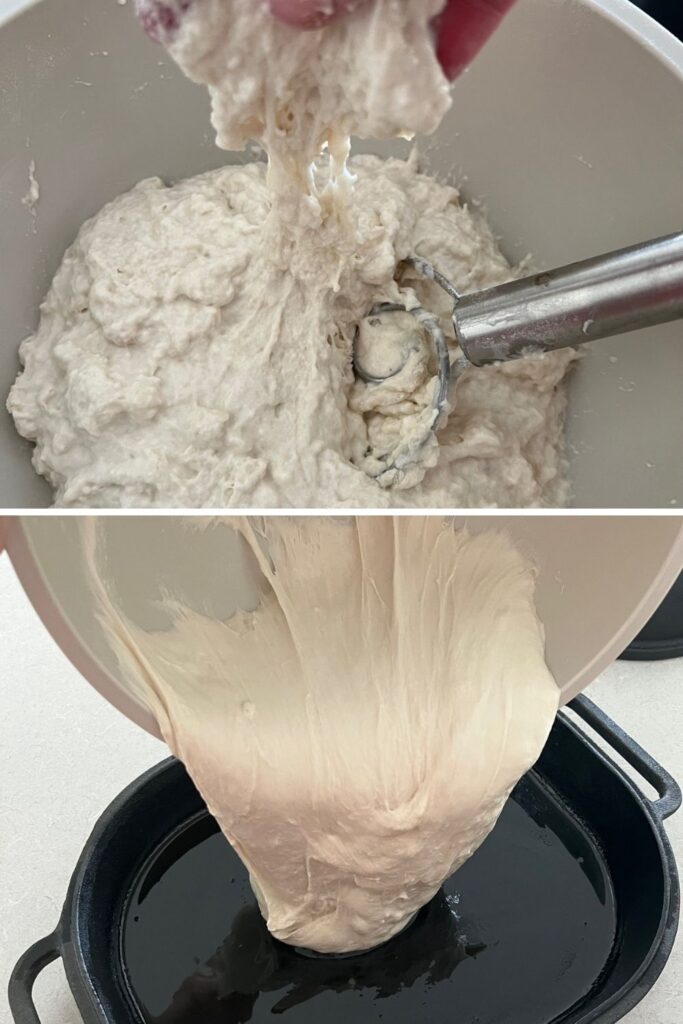
- Dough too wet & sticky - this is a high hydration dough. It will start off really sloppy but the dough should gain strength as you perform the stretch and folds. It should then gain strength and volume during bulk fermentation. Don't stress too much as this is a "free form" type of bread - you don't need it to hold its shape as it is baked in a pan. You can see in the photo above what my dough looks like after autolyse (before I start stretching and folding) - it's a wet mess! But looks how smooth and strong it is after bulk fermentation! Have patience.
- Type of flour - I recommend using bread flour for this recipe. If you need to use all purpose flour, reduce the amount of water by up to 50g because all purpose flour will not cope with higher hydration.
- Not bubbling - ideally you should get some nice big bubbles that form once the dough has been sitting in the pan for proofing. It does need to be placed in a warmer temp (ideally 24C - 28C).
- Dough sticky when dimpling - if the dough sticks to your fingers when you are dimpling it - you need more olive oil!! Seriously, there's no such thing as too much oil! It will give you a crispy outter and so much flavor!
- Focaccia Not Browning in the Oven - this is most likely due to under fermentation. If the dough hasn't had enough time to rest and ferment, it won't brown in the oven, resulting in a pale, unappealing focaccia. Make sure you give your dough plenty of time at room temperature - you want some serious bubbles to form!
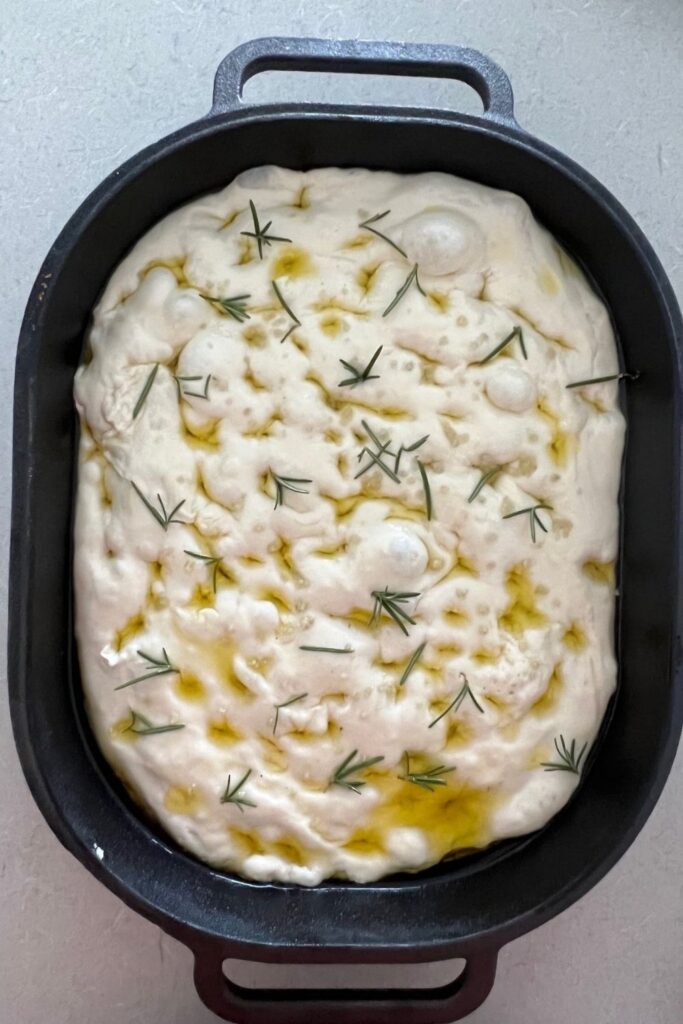
How To Eat Sourdough Focaccia Bread
This sourdough focaccia bread recipe can be served and eaten in so many different ways.
Dressed simply with olive oil, rosemary and salt it can accompany just about anything. Tear it, slice it, toast it, dip it - it lends itself to any occasion. And did I mention this bread dipping oil? It will take your sourdough focaccia to the next level!
It really can be a meal in itself (seriously ... just add wine lol). Oh and some of this whipped herb butter or this cultured butter!
Some of my favorite toppings for sourdough focaccia include:
- Make it like a pizza - add fresh tomato, red onion, olives, mini pepperoni or roll up some salami, shredded ham or bacon, lashings of mozzarella and a generous sprinkling of pizza herbs - YUM! Check out this sourdough pizza focaccia bread!
- Olives, cherry tomatoes and olive oil, with a sprinkling of dried oregano. Add some shaved parmesan cheese once it's out of the oven. Chef's kiss!
- Thinly sliced onion, fresh minced garlic, olive oil and lots of salt.
- Stud the focaccia with red or green grapes cut in half, drizzle with olive oil.
- Drizzle with melted butter, dust it with cinnamon sugar and dip into melted chocolate (seriously it's sooooo addictive!) or try this sourdough cinnamon roll focaccia bread!
- Maybe this Dill Pickle Cheddar Sourdough Focaccia is more your style?
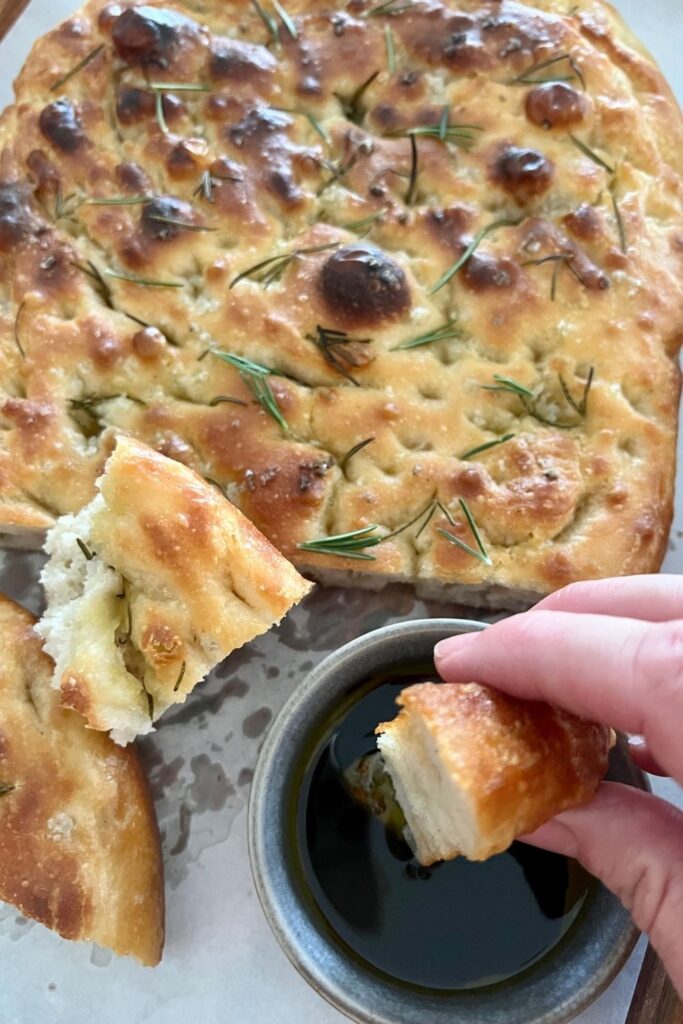
How to Store + Freeze
This sourdough focaccia recipe is best eaten fresh and warm, right out of the oven. That being said, the olive oil will give this bread a longer shelf life. Stored in an airtight container or plastic bag, this will last a few days on the kitchen counter. It makes the loveliest grilled cheese sandwich when it's starting to stale.
This recipe freezes really well. You can cut the sourdough focaccia into squares and freeze in ziplock bags for convenience.
Frequently Asked Questions
This is a question I've been asked a lot, and truth be told I don't usually put a time limit because it will really depend on your sourdough starter and temperature of your kitchen. But when I make this with 100g of sourdough starter, I will bulk ferment it for around 4 to 5 hours and then place it in the pan and allow it to proof until it's really bubbly - this can take another 4 to 5 hours, depending on how warm it is
Many people say to use your over fermented sourdough to make focaccia. You can do this - yes. Will it taste as good as an intentionally made focaccia bread? No. Using over fermented dough to make focaccia will result in a very sour, dense loaf - as opposed to an actual focaccia bread which is bubbly and light in texture and flavor.
It's best to dimple focaccia before you bake it. If you don't, you risk it puffing up too much in the oven and you will lose that bubbly, spongey texture.
You could, but it will take a long time to ferment and it will make the bread very sour. It's best to stick with 100g of sourdough starter - unless you're making it in a very hot environment.
Yes you can - I have chosen not to. If you do add olive oil into the dough, you will need to reduce the hydration as this will make it very wet and soupy. Honestly, drizzling it with olive oil is enough to get the full flavor through the bread.
Yes you can use sourdough discard. But if using discard, you'd need to a pinch of yeast.
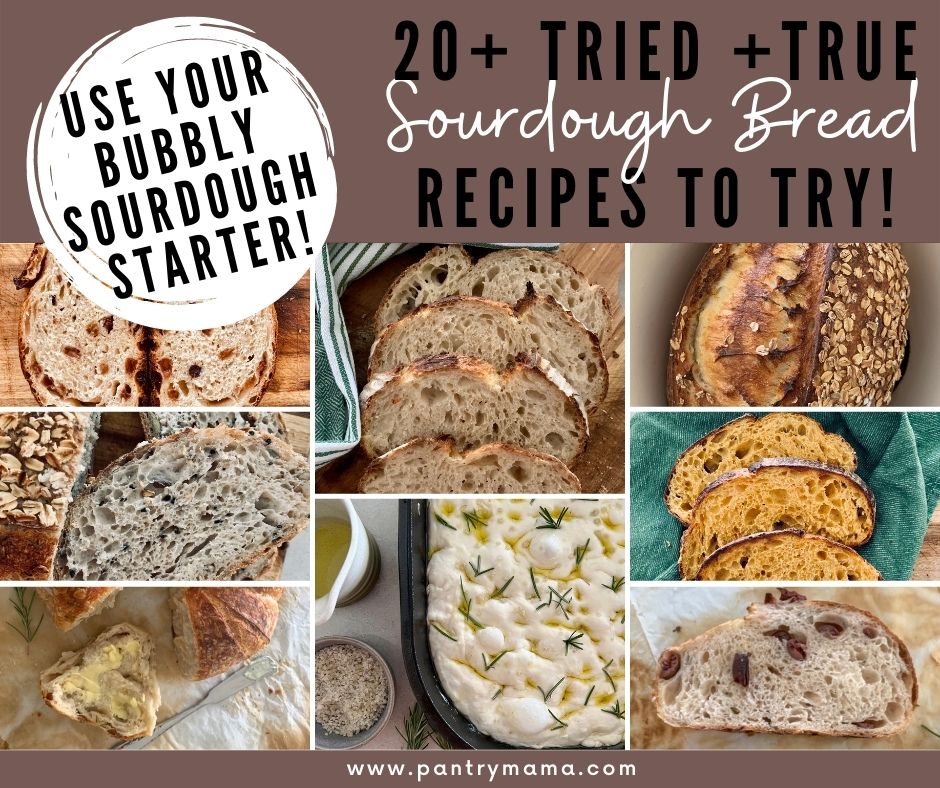
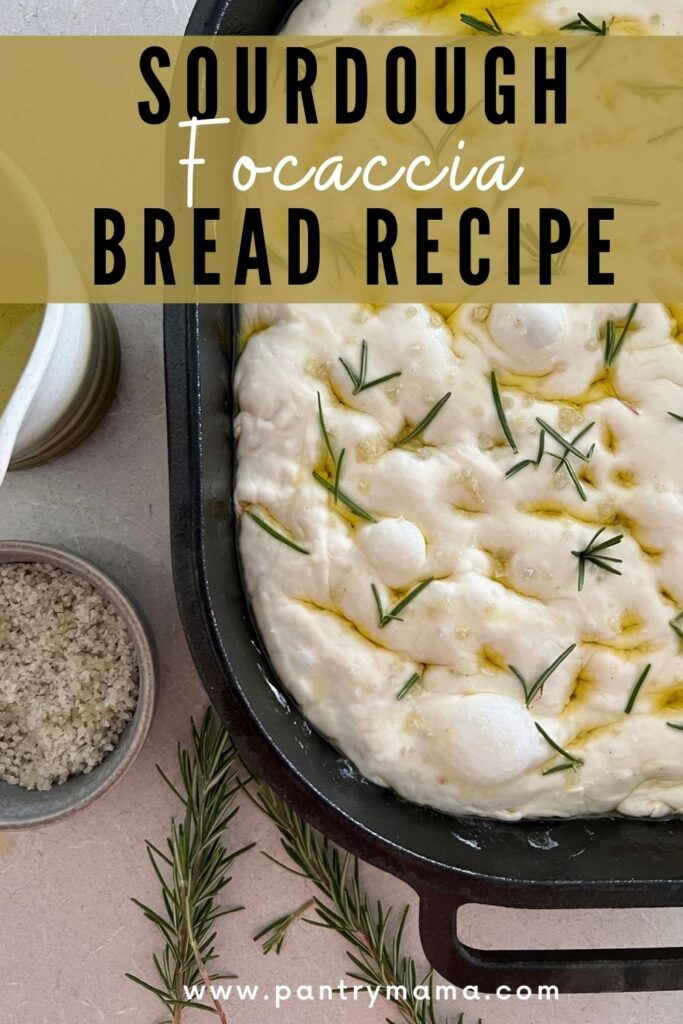
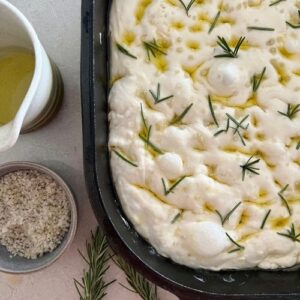
Sourdough Focaccia Bread Recipe
Video
Equipment
- Mixing Bowl
- Digital Scale
- Baking Tray
Ingredients
For the dough
- 100 g Sourdough starter (active and bubbly)
- 400 g Water (can increase or decrease by 30g if desired)
- 500 g Bread Flour
- 10 g Salt (fine salt)
For the topping
- 30 g Olive Oil (extra virgin)
- 10 g Sea Salt (flaky sea salt)
- 1 tablespoon Rosemary Leaves (fresh or dried)
Instructions
- Mixing The DoughWeigh out your sourdough starter and water into a large bowl.Mix the water and starter together briefly. Then add flour and salt and mix whole lot together until it forms a sticky dough. You don't want any dry flour left at all.You can use a dough scraper or jar spatula for this).

- Cover your bowl with cling film or a damp tea towel and let it sit for around 1 hour. It's ok if it's a little bit longer, it's not going to matter too much.

- Strengthening the DoughAfter the dough has been through autolyse you need to bring it together into a ball. Work your way around the bowl, grabbing the dough from the outside, stretching it up and over itself, into the centre. You should feel the dough strengthen as you do this. It doesn't have to be perfectly smooth or tight, just work around the bowl stretching and folding (around 10 - 15 times is perfect).

- Bulk Ferment:Now you want to leave your dough to bulk ferment at room temperature. Cover it with a tea towel or plastic wrap and leave it alone to double (see notes).Focaccia is super forgiving so it doesn't need to be perfectly doubled - near enough is fine.
- Shaping Focaccia:Once the dough has doubled you need to shape the dough. Shaping focaccia is super simple (and absolutely forgiving). See my notes in the post above for details on baking pans/dishes.Use a dough scraper to gently ease the dough out into your desired pan.

- Rub your hands with a little olive oil and gently pull the dough out to fill the tray. Again it doesn't have to be perfect as it will naturally fill the tray as it proofs.

- Second Rise:Let your dough rise again. Leave it until it's spread out and filled the tray. It will be puffy and pillowy ... you might even have some gorgeous bubbles popping up.

- Topping:Once the dough has filled the tray and is looking puffy and full of volume, you need to dimple the dough and add the toppings.Pour olive oil over the top of the dough and then push your finger tips into the dough to create dimples. You might see some bubbles as you do this.Now sprinkle with sea salt and rosemary.

- Baking Sourdough Focaccia:Preheat the oven to 200C (392F).Bake for 30 minutes or until golden brown.

Notes
- Cast iron skillet or bread pan (the skillet I'm using is 39cm x 26cm (15 x 10 inches).
- Divide into two portions and bake in round cake tins lined with parchment paper (I do this with 20cm (8 inch) cake tins.
- Baking tray (either using olive oil or baking paper) - any medium sized tray is fine, the dough can stretch out to fit.
Nutrition

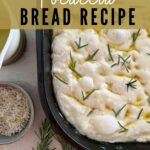
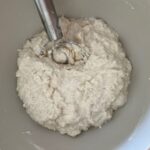
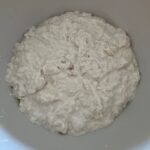
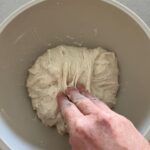
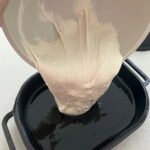
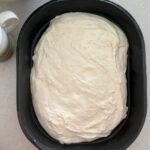
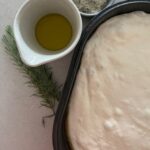
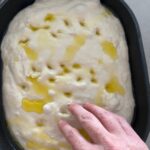
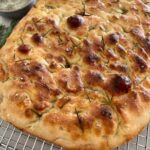
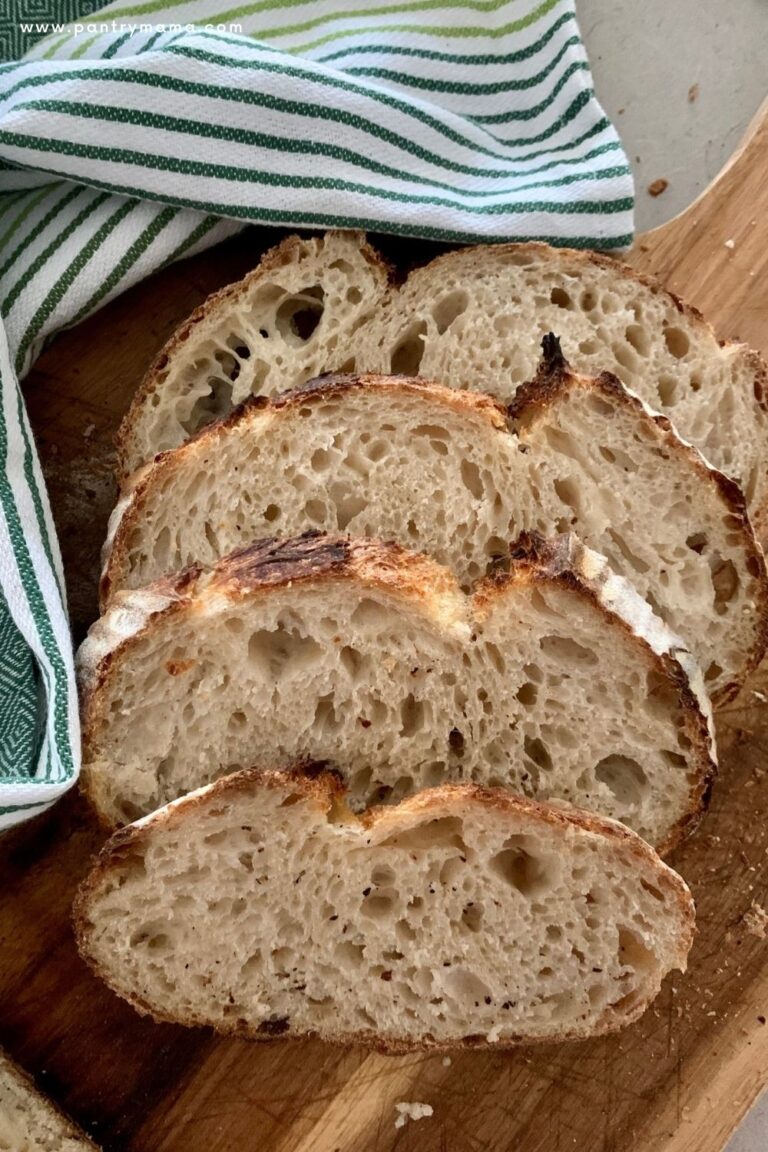
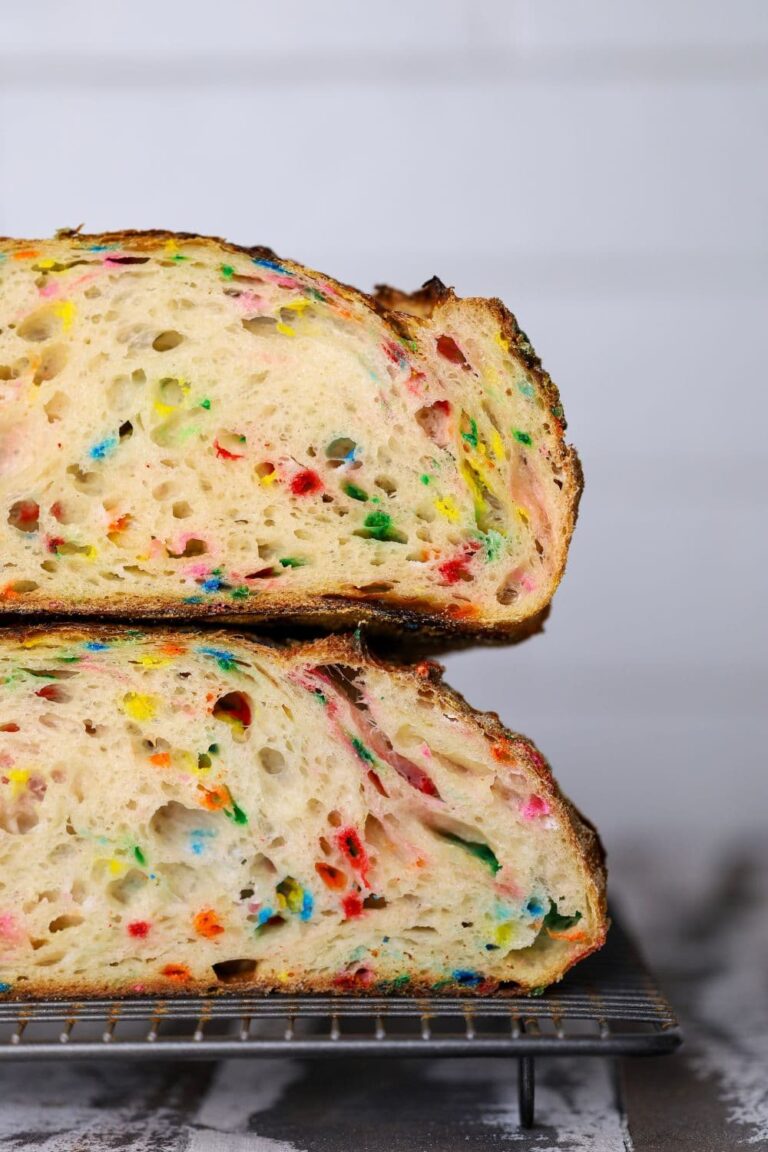
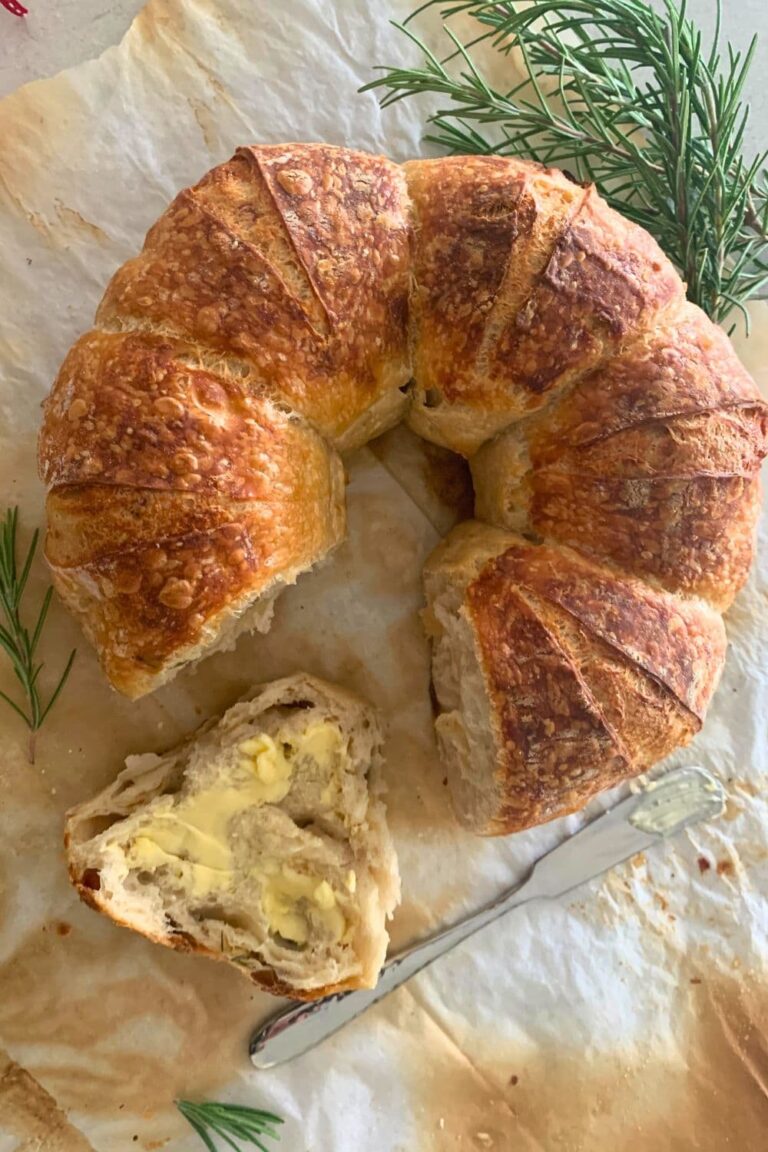
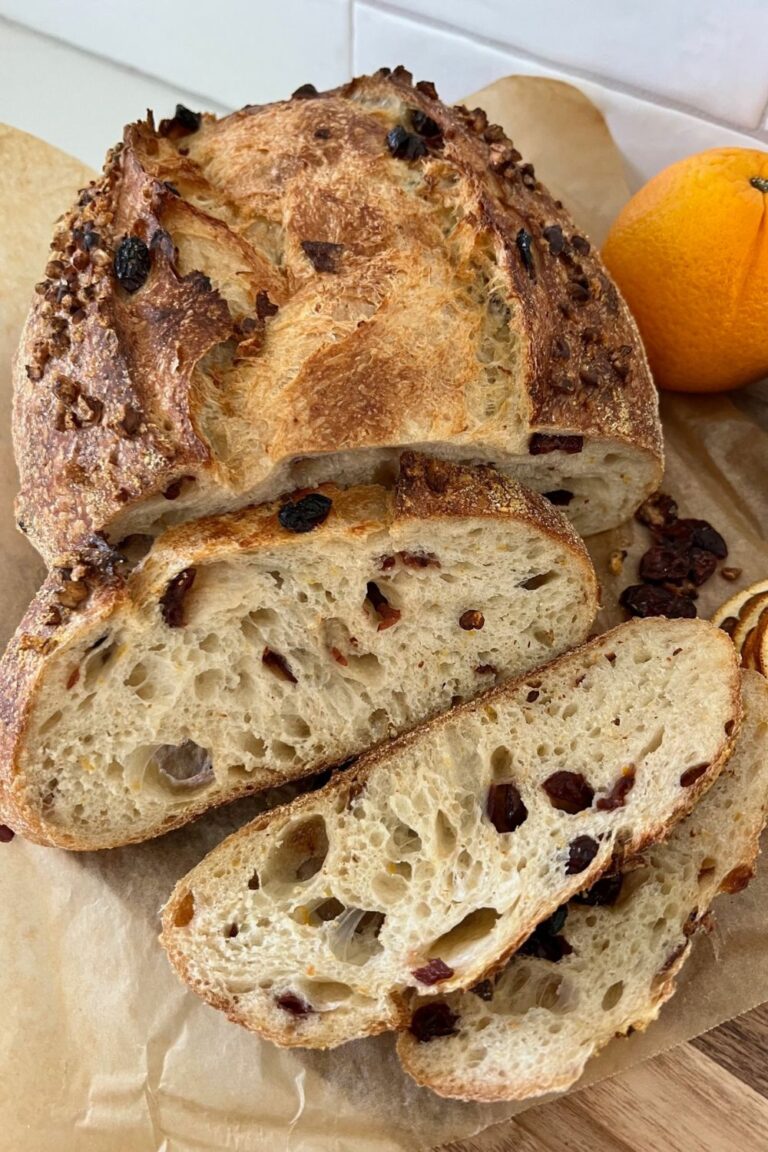

I have loved every Pantry Mama recipe have tried. Last night I pulled my starter out of the fridge and fed it so I was ready to go this morning, planning to bake in my cast iron skillet and top with fresh herbs from my garden, garlic cloves and a few black olives!
Hi, I'm new to sourdough and my first attempt at this recipe was a total fail BUT I just had my second attempt which seems to have worked out (I haven’t cut into it yet to really see) I used a 9x9 square baking pan for my second attempt but it seemed to puff up in the middle and doesn’t look uniform - is this normal?
Sourdough focaccia can be a little tricky, but the best thing is the result is generally edible 🙂 Focaccia dough does look quite bubbly and not uniform on top, that's one of the best things about it, it's so forgiving xx
I'm at the strengthening the dough step. I have folded it 50 times and it won't form a ball? Can I work the dough to much, if I keep folding it? Thank you
It's ok for focaccia - the dough is very wet so you want to strengthen the dough, but it's ok if it's not because you will pour the dough into a baking pan and let it rise in there 🙂
Best focaccia I've made. I used half bread flour and half whole wheat and it was still wonderfully fluffy and moist. Thank you!!
Love to hear that, Natascha!
Hi, I am making this today and currently awaiting for the second rise to finish. I did notice when I did the folds that there were only what I can describe as a lumps in the dough. I tried to feel for them as I was doing the fold And break them up with my thumb and forefinger. I thought I got them all but when I put the dough into the pan and started stretching it, I felt a few more. What caused this? I can say for certain that I use the exact measurements that were given.
This does happen sometimes and it's not a big deal. They should disappear during fermentation and definitely during the cooking process 🙂
So I’m terrible about following recipes to a T, so I made this but instead of putting all of the toppings on top, I folded them in. So far I have made an Italian pizza, and now a Philly cheese steak one. They have turned out AMAZING, and a huge hit at home and at work. It’s so easy!
Hands down the best sourdough focaccia recipe. It never fails! I sometimes turn it into pizza and it’s the most delicious pizza.
This recipe is amazing and so easy to make. It’s been huge hit and has turned out so well each time!
This was my first time trying this recipe. Easy to follow. My family loved the outcome. How do I post a picture?
Hi Janice, we don't have the option for posting a picture here, but if you have an Instagram, we would love you to post and tag us @thepantrymama. Or if you have a Facebook, we have a Facebook group with active members who also love to see what you made. You can join that group here. 🙂
I’d love be to receive your emails❣️
A friend of mine received them & told me I should sign up && now I’m looking forward to 🎊🪅🎉
Love everything I’ve seen from U🎉
Thank you so much, Jana! We'll get you added to the email list. 🙂
This focaccia is SO GOOD!!!! Thank you so much for the recipe. Love that I can start it the morning and have it ready by dinner.
I have been baking foccacia for many years now and this was the first recipe that turned out very fluffy and perfect! I went for the pizza version and it was amazing!
This recipe makes an excellent focaccia.
I also made a second batch and used it to make an olive oil and basil loaf. It’s was amazing. Love the high hydration.
I recommend this recipe.
I split this recipe into the two 8in round cake pans and we almost finished an entire loaf at dinner the other night. This focaccia was so flavorful! I used bread flour and AP flour and I can't wait to make it again. It made a great little surprise gift for some friends. Thank you for the recipe!
We love to hear that! Thanks for your comment, Kendall! 🙂
Loved it. Easy and quick to make. I was able to do the second rise in the fridge for several days, I lost track, it might have even been three days and it turned out great. Have made it twice. 30 minutes seemed too long for my oven so the second time baked for just 25 minutes. I froze it and then used it to make pizza, put toppings on and into the oven while it was still frozen and it was the BEST.
I want to make this recipe with my students, but I want them to decorate like a garden focaccia in small groups. Do you think that it could work if I split the dough in half and used a smaller pan?
Yes, that should work!
Hi, I was wondering if I can leave it cold fermenting over night and bake it with the rest of my breads. What would you suggest?
Yes you can cold ferment this recipe, I've added information for this under "Baker's Schedule" 🙂 I hope this helps xo
Amazing focaccia! My hubby said it was just like a shop bought one. (He thinks that's a compliment! Hahaha)
Haha! I love it. Thank you Belinda (and Husband!). We appreciate the review. 🙂
How long should it bulk ferment?
I generally bulk ferment around 5ish hours, but it depends on temperature. I've added a baking schedule for sourdough focaccia to the post above 🙂
I made this focaccia to take to a dinner with friends and everyone loved them! They all took some home and there was none left. They came out simply perfect. Thank you so much!
Such an easy recipe to make thanks. I can’t however get the top golden brown ….even if I leave the focaccia in the oven for a longer amount of time, so it’s very anaemic looking!! What am I doing wrong?
I would say this is because the dough hasn't been bulk fermented correctly. Try to leave your dough a bit longer. You also want to ensure it's super bubbly before you place it into the oven 🙂
Hi! I like to use the broiler and a rack up high in the oven for just a minute or two to achieve the color and browning of high spots that is so beautiful in focaccia. I hope it works for you too.
First rise was beautiful but second rise was a bust. I used a cookie sheet/baking pan(about same size as recipe called for), it spread out nicely but did not rise or get bubble. Do you think the first rise went too long? (14hours)
Yes 14 hours would be too long for the bulk fermentation 🙂
Can I get some time estimates for these different steps?!
Hi Katie - I've added this information into the post, including a baker's timeline which I hope will help you navigate this recipe more easily 🙂
Awesome recipe. I had to adjust my he water down to. 370g it’s a family favorite.
Beautiful recipe. I love that it makes enough for two - one for us and one to share. I also love that it uses a good amount of starter, as ours is active and happy and always ready to be used. We dotted our focaccia with baby tomatoes from our garden, cut in half, as well as our rosemary and flaky sea salt. We made ours tall enough to cut in half and make sandwiches. This morning, we served egg and cheese sandwiches with it, and they were devoured. I recommend reading over the recipe well so that the timing of steps is clear, and committing to it when schedule allows. It is worth the process.
I just made this for the first time and it came out perfectly! Great recipe, steps, and tips! This will be a favorite and regular! Thank you!
Love the recipe and have made this many times, always with an overnight ferment and a long rise the next day on the countertop. One tip I'd like to to share is to place the pan on top of a pre heated baking steel/cast iron pizza stone when you put it in the oven. You'll get a great crispy bottom this way.